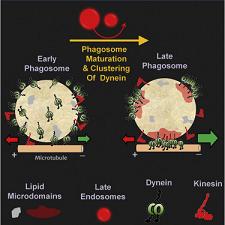Cell:胆固醇有助清除病原体
 2016-05-25来源:未知
2016-05-25来源:未知近日,国际著名学术期刊《Cell》杂志在线发表印度Tata基础研究院的研究人员Roop Mallik教授揭示细胞内胆固醇有助清除病原体的机制。研究表明,我们免疫系统的细胞,可通过将病原菌封闭在一个称为吞噬小体(phagosome)的隔室内,将它们杀死。马达蛋白携带的吞噬小体,最初在细胞边缘来回地移动,并通过与其他隔室融合而成熟。随着时间的流逝,有一个开关,可使吞噬小体以一种几乎单向的方式向细胞中心移动。在这里,它们与酸性溶酶体融合,以便于病原菌可降解。
吞噬体运动中的开关,对于病原菌的降解非常重要,这在结核分枝杆菌和沙门氏菌中已经观察到,这些细菌能够中止这一开关,作为生存和感染的一种策略。
研究人员发现,吞噬小体命运的“开关”, 是因为在吞噬小体膜表面形成了富含胆固醇的结构域——被称为脂筏。Roop Mallik教授指出:“我们发现病原体到溶酶体的运输,是由许多纳米级动力蛋白马达的聚集实现的。”
动力蛋白聚集到这些脂筏结构域中,并通过这样做,能够以大型团队合作。这种胆固醇可诱导动力蛋白集群,将吞噬小体运输到酸性溶酶体,用于降解。这项研究的结果将于。
重要的是,他们还表明,来自寄生虫利什曼原虫(可引起内脏利什曼病(黑热病),许多热带国家包括印度的地方流行性致命疾病)的一种脂质分子,能够扰乱动力蛋白的聚集,从而阻止吞噬小体到溶酶体的运输。通过这种机制,利什曼原虫可以通过在我们肝脏和脾脏的免疫细胞中生存与繁衍,而将感染进一步扩散。
Mallik教授说,“这一发现可能有助于制定治疗策略对抗这种危险的感染。这些结果也与导致结核病和伤寒的病原体密切相关。我们的工作也表明,我们所厌恶的胆固醇,能有效的清除感染。”

原文链接:Dynein Clusters into Lipid Microdomains on Phagosomes to Drive Rapid Transport toward Lysosomes
原文摘要:Diverse cellular processes are driven by motor proteins that are recruited to and generate force on lipid membranes. Surprisingly little is known about how membranes control the force from motors and how this may impact specific cellular functions. Here, we show that dynein motors physically cluster into microdomains on the membrane of a phagosome as it matures inside cells. Such geometrical reorganization allows many dyneins within a cluster to generate cooperative force on a single microtubule. This results in rapid directed transport of the phagosome toward microtubule minus ends, likely promoting phagolysosome fusion and pathogen degradation. We show that lipophosphoglycan, the major molecule implicated in immune evasion of Leishmania donovani, inhibits phagosome motion by disrupting the clustering and therefore the cooperative force generation of dynein. These findings appear relevant to several pathogens that prevent phagosome-lysosome fusion by targeting lipid microdomains on phagosomes.



